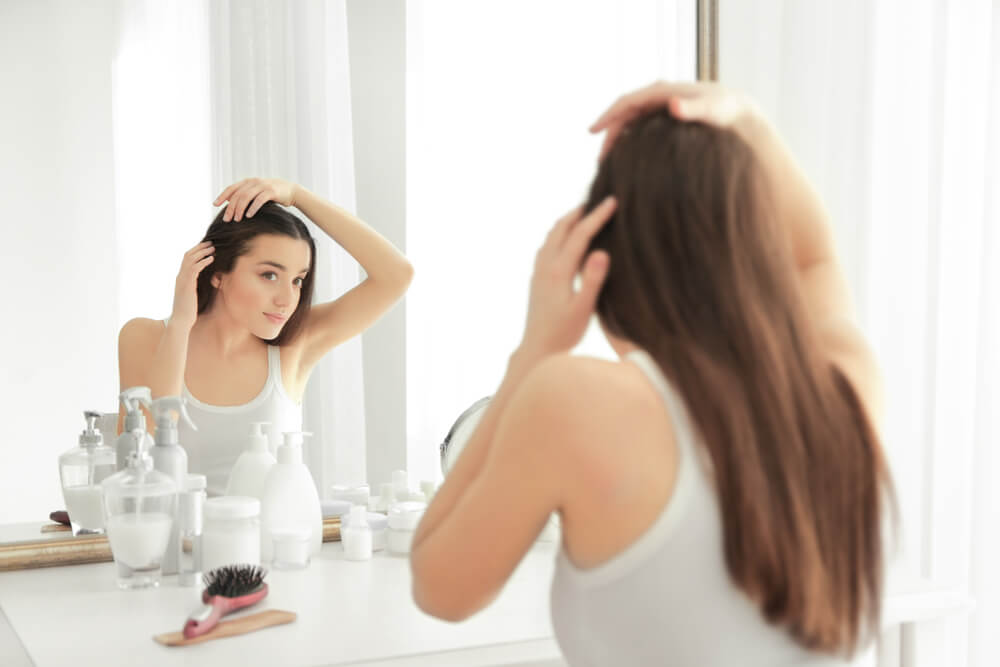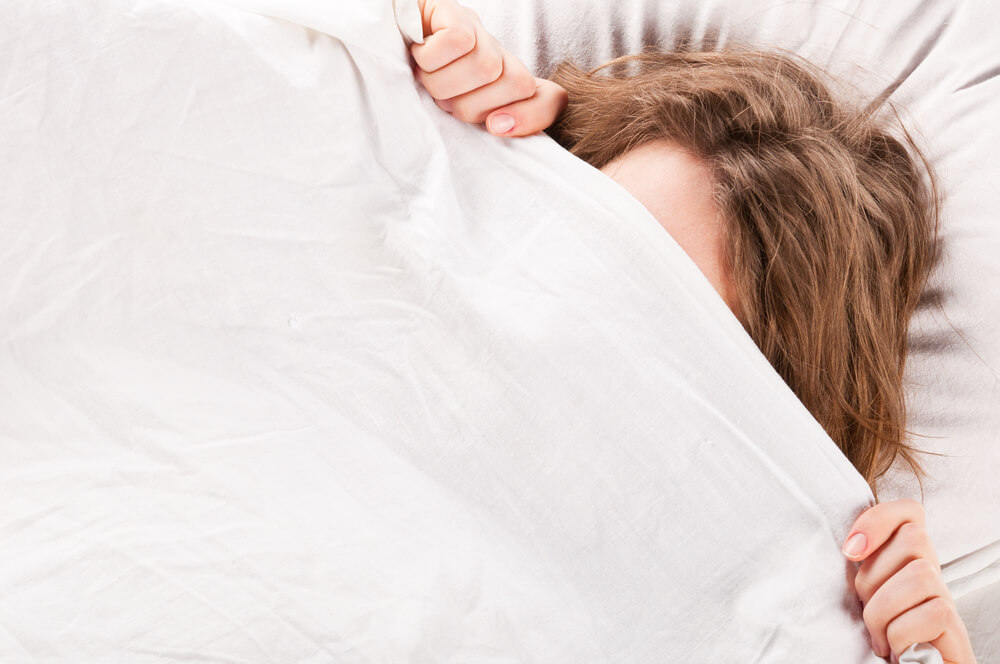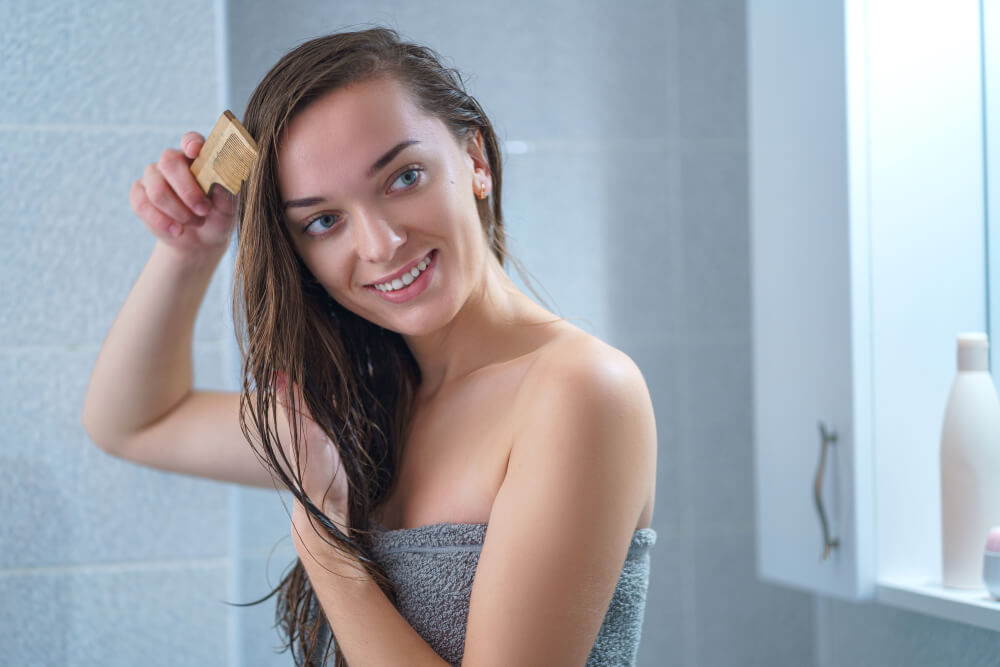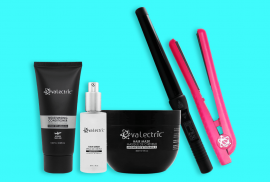Is it Actually Bad To Sleep With Wet Hair?

You may have always heard the old wive’s tale about it being bad to sleep with wet hair. In the past, people believed that doing this might cause you to catch a cold or pneumonia, but while that isn’t necessarily true, could it still be possible that sleeping with wet hair is a bad idea? Studies say yes!
Join us at Evalectric as we take a closer look at the reasons why…
Hair Damage

Sleeping with dry locks can actually protect your hair from damage. At Evalectric, we believe that it’s so important to keep your hair feeling its healthiest, making this an important point to look into further…
When your hair is wet, it is at its weakest.
The protective layer of your hair shafts is structured like the shingles on a roof, with the cuticle layers overlapping each other. When your hair is wet these expand causing the flaps to stand up, exposing the weak areas. If you are tossing and turning on a rough pillow with wet hair, this can increase the chance that you are stressing and pulling on weak spots causing tangles and breakage, thereby further damaging your tresses.
Even if you are not a restless sleeper, sleeping with wet hair is a bad idea. A pillow can soak up the moisture and natural oils that you want to keep in your hair. Since the hair shaft’s protective layer is fluffed up, this allows moisture and nutrients to escape. Dehydrated and depleted hair loses the shine and vitality that healthy hair needs to thrive.
If your hair is already damaged and prone to tangling, be really careful when working out the knots while it is wet. There are right and wrong ways to get your hair tangle-free and knowing them could be very helpful to achieve healthy-looking locks.
- Use a product that smooths and softens the feel of your hair. A leave-in product, such as the Evalectric Hair Serum, can actually help you get through the difficult process of detangling. Hair shafts that feel hydrated and sleek will loosen their hold on other strands, making it easier to get out knots and snarls.
- Work your way from bottom to top. Starting at the bottom allows you to work out each tangle a little at a time so that you are not bunching a whole lot of tangles together from the top to bottom, resulting in a mat you might not be able to brush out at all.
- Use short, smooth strokes. Taking small sections and gently working through each tangle a little at a time reduces the chances of breaking your hair. Try not to be too rough – patience is a virtue and your hair will thank you!
- Choose the right tool for the job. It might seem ridiculous to have more than one brush, but there are differences in what you should use for wet brushing versus dry brushing. Some brushes are especially designed for detangling wet hair with gentle flexible bristles that get through your hair without tugging on weakened areas. A wide tooth comb is also a great option. You could even get a brush that dries your hair while you work out those persistent knots!
- Use gentle heated styling tools on damaged hair – once you’re done de-tangling, don’t subject your hair to harsh treatment. Instead, if you need to use a heated styling tool, go for something with adjustable heat levels. You’ll find this handy feature on each Evalectric hair straightener.
Headaches
There have been some studies that suggest that sleeping with wet hair may actually cause headaches for some people. The water on your scalp may be soaking into your skin causing water weight and an uncomfortable feeling of blocked sinuses which may lead to piercing headaches.
It might be worth trying to change the habit and seeing if it helps lessen the number of times you wake up with or develop a pounding head. Taking a few extra minutes at night to dry your hair or changing the time you take a shower might turn out to be a simple solution to a painful problem!
Plus, if you have a good hairdryer, drying your hair before bed doesn’t need to take very long at all.
Dandruff

Usually, dandruff is associated with a dry scalp…
So how does going to bed with wet hair worsen flaking problems?
When your hair is damp for long periods of time, it interrupts the natural healthy oil production your scalp needs to maintain a balanced sebum level. Too much oil or too little can aggravate any skin conditions like eczema and psoriasis, making the itchiness and flaking much worse.
Skin Issues
Sleeping with wet hair might cause you to have fungal or bacterial infections on your skin!
If you are dealing with dandruff or breakouts on your scalp or upper torso it may actually be a nasty infection. A specific yeast called Malassezia infects the hair follicles and is usually confused as an acne type breakout or dermatitis.
The main difference is that Malassezia folliculitis causes your skin to be itchy whereas acne does not. This condition can definitely be treated and avoided, so if you suspect it or have been diagnosed, there are things you can do. Using an anti-fungal shampoo or topical treatment can clear up infections and drying your hair before bed can keep these issues at bay.
Other bacterial and fungal infections, such as ringworm, and mold growth are also possible because these types of things thrive in damp, dark, and warm places. When you sleep with wet hair, you are risking having to deal with problems such as dandruff, hair loss and worsening skin conditions. Ringworm is also highly contagious which means you could possibly pass it to a family member.
Your pillow might also be a hotbed of bacteria, mold, and fungi if you have been in the habit of getting it damp with your hair. This can be a big problem for people who already have any respiratory ailments like asthma, emphysema, or COPD. If you are at risk for making a chronic condition worse, be sure and sleep with dry hair, put a protector on your pillow, and change it often.
Lowered Immune System
While having a wet head at night might not cause you to get a cold, flu, or pneumonia, it could potentially put you at risk of getting sick from the viruses and germs that are the true culprits of getting an illness.
There are conflicting opinions out there about if sleeping with wet hair can actually lower your immune system or not, but even if it does not there are plenty of reasons to avoid it. If it does lower your body’s defense system, that could be just another good reason to take the time to change a bad habit!
Bed Head

If you have ever gone to bed with wet hair and woken up looking like you got in a fight with a leaf blower, you know the struggle of bed head. Going to bed right after washing your hair can cause it to dry while being pressed into undesirable directions.
This sets in knots and cowlicks that make styling and getting your hair to look how you want pretty difficult. Having to overwork your hair just trying to control it can lead to even more damage.
Having dry hair already set in the way you want it, gives you peace of mind while laying your head down to sleep without worrying about having a wild mane in the morning!
How to Avoid Problems If Your Hair is Wet at Night
There are steps you can take to ward off the problems sleeping with wet hair can cause:
- Wash hair at a different time of day. Showering or bathing earlier in the evening or in the morning allows you to skip the problem of wet hair at bed time completely.
- Dry your hair as best you can before bed. If you can not change your nightly routine, try to get your hair as dry as possible. Use a hair dryer, even if you do not have a lot of time, you can briefly hit the underside and at the scalp since these areas take the longest to dry.
- Leave your hair in a towel for as long as possible. While sleeping with a towel on is not a good idea either because it keeps your scalp damp as well, you can leave your hair in it while you take care of other nightly routines. Before getting out of the shower, squeeze as much water out as you can so that your towel can soak up the extra moisture without getting too saturated. If your hair is still pretty damp try blotting with a secondary cloth.
- Add a leave-in conditioner. If you absolutely can not have completely dry hair before bed, you can take steps to protect it. Applying a leave-in conditioner can smooth the cuticle layers of your hair shafts, sealing in moisture and making your hair resistant to damage.
- Sleep on silk pillowcases. Not only do they feel luxurious, silk pillowcases are far less abrasive to your hair than cotton or other types of material used. This is a fairly cheap investment to reduce the chance of damaging your hair while you sleep.
- Use waterproof pillow protectors. To reduce the risk of having the various types of bacteria, mold, and fungus making your pillow their home you can get waterproof pillow covers. Great strides have been made in making these protectors effective while eliminating the plastic crinkle encasements of the past. Your pillow can be safe from undesirable microorganisms and you can rest comfortably.
Styling Wet Hair

If you do end up sleeping with wet hair, there are steps you can take to try getting the perfect roll-out-of-bed hair:
Braiding
Braiding your hair while it is still damp is one of the easiest ways to get a beach wavy look that looks great. Another perk of braiding hair to sleep is that it can protect the individual strands from getting pulled, tangled or kinked.
Be sure to braid your hair loosely instead of too tight, for a breezy crimpless look. Apply a serum, such as the Evalectric Hair Serum, for waves that look soft and frizz-free in the morning!
Buns
Pulling your hair up into a bun or two is another way to protect your hair from abrasive movements at night. This can also add volume to thin hair that is prone to flatness. Gently wrap your hair on top of your head and secure comfortably, either with bobby pins or a scrunchie.
Using a hair tie might put an unsightly mark wherever it was that will be very difficult to get out in the morning. Be sure and add a smoothing agent to help keep your hair looking sleek and healthy.
Hair Scarf
A silk scarf can have the same effect as silk pillow cases. If you are especially prone to tossing and turning at night you can wrap your hair up neatly and tie a scarf around it to prevent tangles, breakage and frizz.
After applying your favorite hair-loving serum or leave in conditioner and add a silk scarf for even more protection. Your hair will look fresh and ready to style in the morning!
Rollers
The women of vintage times might have been onto something with the soft curlers at night. If nicely curled hair is the look that you are going for, but you want to avoid overprocessing, this might be an option to look into.
Instead of dealing with unruly locks in the morning your hair can already be set and ready when you remove the curlers. Be sure to get the size for the type of curl you want and a style that you can comfortably sleep in. You can also wrap a silk scarf around rollers and use a protectant leave-in conditioner or the Evalectric Hair Serum to wake up to silky-feeling, frizz-free curls in the morning!
All in all, there are plenty of reasons to change the habit of regularly sleeping with wet hair. From bodily harm to hair damage, having a wet head at night is actually a pretty significant problem creator. Since almost everyone eventually realizes that it does not cause a cold, it becomes pretty easy to get comfortable with doing it in spite of warnings.
Misinformed advice can often cause more harm than good and this is an instance where that has proven true. The eye-opening research done on this habit could definitely change anyone’s mind about it being harmless, and here at Evalectric, we want you guys to be armed with all of the facts. So, the next time you are tempted to skip a few steps, keep in mind that it’s not worth it!






